Iain Murray Interview: Skippering ACRM
September 21, 2011
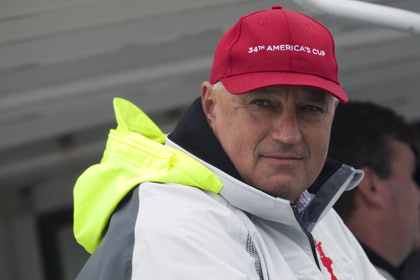 |
|
|
Iain Murray, Director ACRM. Photo:©2011 ACEA/Gilles
Martin-Raget |
Iain Murray, Regatta Director and CEO of the America's Cup Race Management
(ACRM) organization, in charge of independent conduct of the regattas, and
at the lead in pushing forward all the changes necessary for the America's
Cup World Series, the 2013 Louis Vuitton Cup and the actual America's Cup.
CupInfo checked in with him last Sunday on the final day of racing in
Plymouth. Iain talked about ACRM's focus going forward, plans for
changes at the next ACWS stop in San Diego and for 2013, and the
possibility of new teams joining up:
CupInfo:
Iain, after the first two events, are the World Series showing their full
potential already?
Iain Murray:
Weíve developed a whole lot of boats and an event and new tools and cameras and the way we run races and umpiring and, look, itís going well. Thereís no question that I think weíve met our targets. Itís not that weíve got wonderful tools, itís how we use them to the best of our ability in the most efficient way that we can, and get the most out of them in terms of the races -- getting great races, the viewers getting great pictures, the audience on the hill getting a great experience, all of those sort of things. We have to work harder, to detail what weíre doing, to make it tighter and better.
CupInfo:
How much of the technology have you been able to use, so far? 30%,
60%, do you think?
Iain Murray:
Weíre using most of the technology ... everything we set out to develop is up on line and we're using it. Are we getting 80-90% out of it? Probably not. Weíre probably, I think at this event, probably got 70% of what we could get, out of what weíve got. So thereís clearly still a lot of work to do. We were probably at 50 or 60%% in Cascais, weíve chipped up here a little bit, and we're going to get better and better.
CupInfo:
What are the main developments in the pipeline for Race Management?
Iain Murray:
I think weíve got to look at the race courses, how the crews manage the boats, how they get better, how we bring the race courses into the public arena, what television shots we have, how the commentators think ahead, who selects the pictures, how they see the events of the race unrolling. Thereís so much we can get ahead of the curve on, that we really need to.
CupInfo:
Speaking of spectators, should the umpires be more present on video or
audio feed (as in American Football, with the microphone turned up)?
Iain Murray:
Well, once again thatís a detail that we can look at, and you know we are really looking for direction from the TV, which comes from the audience, as to what they want. You know, we have the umpires and their decision making, and how much of those flow on into the broadcast ... thatís a decision for ACTV. Itís all there, itís the production of TV. If people want it, theyíll get it.
CupInfo:
Do you think umpires in the booth render the sport of sailing easier to
understand?
Iain Murray:
What people donít understand is when a race finishes and then thereís a winner determined afterwards. We have conquered that. Who wins our race on the water, wins the race. So we donít have disputes, decisions, juries, making decisions late into the night as to who is winning our races. Typically when you see the race finished, youíve finished the race. I think that is a major step forward for sailing. The details of the umpiring and fairness on the course, weíre not going out of our way to make that a public part of what it is. Weíre about the race. Itís not about the dispute or the detail of the thing, so until someone asks us to put more on, it will be what it is.
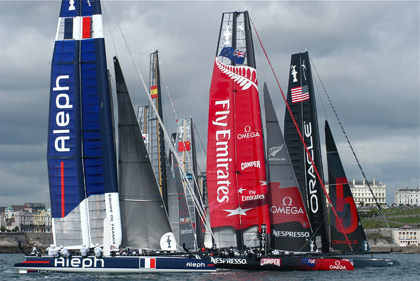 |
|
|
Photo:©2011 CupInfo |
CupInfo:
Is nine boats an ideal fleet for you? Does the number of boats impact
the choice of venue?
Iain Murray:
Eventually it will. Each base takes up space ... we use a lot of space. We have a lot of equipment, a lot of boats, a lot of teams. Itís hard to see if we got beyond 12 boats, I think thatís going to be more difficult for us to manage. Weíre sort of geared up for 12 boats in terms of cameras and equipment and bits and pieces, and I think we can manage that successfully, but weíll play it by ear. We have a lot of interesting teams going forward and ... it will sort itself out over time.
CupInfo:
The potential new teams, are these from European countries only? How
close are we to seeing an Italian team join in Venice or Naples?
Iain Murray:
Iím very positive that we will see an Italian team in the not too distant future. We have -- look, weíre doing discussion with many European teams and southern hemisphere teams -- we have a lot of interesting teams right now.
CupInfo:
So Golden Gate already confirmed they would accept any late entry?
Did they provide this kind of assurance already?
Iain Murray:
Well, Golden Gate have said that they -- theyíre not saying they will accept any entry, theyíre saying that theyíre happy to discuss any entry.
CupInfo:
Have they rejected any French entry?
Iain Murray:
They havenít rejected -- well, we havenít had another French entry at this stage, so nothingís been rejected.
CupInfo:
How do Race Management and the Event Authority collaborate in the venue
selection process?
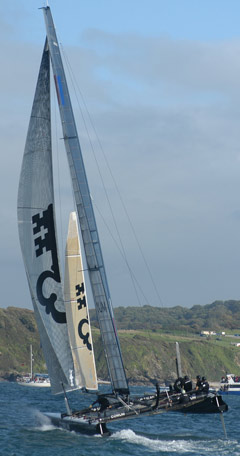 |
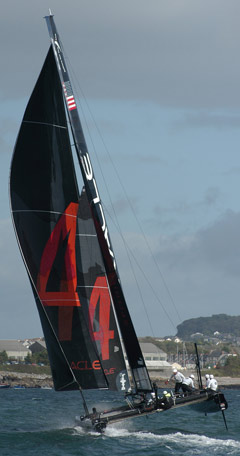 |
|
|
Though the AC45 catamarans are one-design,
including the wingsails, the teams may design their own soft
sails. Energy, above left, and Oracle, right. |
||
Iain Murray:
From our point of view ... weíve got a big part, which is logistics and bases. We are looking for running races in close proximity to shore, and we are looking for wind. Wind is a vital ingredient of what our makeup is. We donít need huge wind, but we need consistent wind.
CupInfo:
There is consistent wind and space in many challenging countries. Why
donít we have World Series events in countries of "commercial teams"
challenging?
Iain Murray:
The Event authority is trying to run this on a commercially sensible basis. Clearly running an Americaís Cup event -- a World Series event -- is a very expensive operation. If the income is nowhere near the cost, itís not going to happen. A vital part of what Iím saying -- which is wind, logistics, venue space -- [there's] obviously got to be a reasonable amount of revenue generated to pay for this. We are very expensive to run with ships and all of what weíre doing. Itís a complex equation.
CupInfo:
The feedback for the 45s is really great from the teams. Are the
plans going on schedule for the Youth America's Cup, or should we expect
these boats to race in 2013 at all?
Iain Murray:
We have always said we would be running a Youth Championship in San Francisco. Itís part of the Host City agreement and we were planning to run youth events in both 2012 and 2013. Americaís Cup also has plans for other youth things which are not disclosed at this stage. We are working with the youth in every venue that we go to, but there are some plans afoot that havenít been the highest priority today, but theyíre at the top of the list now.
CupInfo:
Besides training, boat handling, and tactical decisions, the choice of soft
sail seems to be quite decisive for this class. How open is the sail
development? Is everyone on an equal footing there?
Iain Murray:
The soft sails is a choice of the teams. They have a limited number that they can use, and how they use them and when they use them is their call. I think the teams are basically in consensus as to where weíre at. We are under review at this moment, and itís never going to be perfect for everyone, and as time goes on peopleís choices and bits and pieces in hindsight may not appear to be correct. Thereís always going to be winners and losers, but itís the teamsí choice. Weíve thoroughly consulted with them and we are just trying to tie it down now for the future going forward.
CupInfo:
Why were the soft sails left outside one-design rule for the 45s?
Iain Murray:
It was to allow the teams to establish their sail making teams, their designers, to give them an introduction into the AC45, and, of course ,the wing-sail/soft-sail combination going forward. We have teams that are aspiring to step up into the 72s and thatís a vital part of it. Traditionally, through the America's Cup sails have been a development aspect, and in this one-design class the desire to involve people from all forms of sailing, all types of sail-makers, to support their various teams is a very important measure.
CupInfo:
On course design, whatís the overall logic? Why the changes in the
Plymouth course design, more laps, port rounding, finish line separate from
the start line?
 |
|
|
Image:©2011 ACRM |
Iain Murray:
Well, coming into Plymouth we had port starts and finish line separate, that was part of our original courses that we outlined. We are modifying the courses to fit within the geographical boundaries. We are moving to make changes to enhance the product as we see fit and work with the teams. I think itís fair to say that reaction from the crowd on the Hoe has been beyond our expectations here. We are working to modify it, to work in wind directions that we didnít think that we would get, to make the courses right for all. So we want a combination of a good show, but we also need to maintain the integrity of the race course.
CupInfo:
Should there be a specific race course design for match racing?
Iain Murray:
We have those, basically. Specifically we have a reaching start and we have reasonable upwind and downwind legs. If we put a bit of other features in that are challenging, thatís the way it will be.
CupInfo:
So we may see new courses today (Sunday) for the fleet race, or in San
Diego even?
Iain Murray:
You will see different courses for San Diego, specific to San Diego, and today you are seeing a new course introduced today, Course 7.
CupInfo:
On scoring: there were a number of changes between Cascais and now.
Three points are now given to DNS, OCS, or DNF boats. Disqualified teams
score zero. Are the teams happy with this part of the rules yet?
Iain Murray:
The teams voted on that part of the rules.
CupInfo:
What do you think?
Iain Murray:
I think itís happy. The consensus is prevailing. All the changes you talk about are really part of Rule 20, which has been under great debate. Itís been worked to death by the teams and their advisors, and we are just trying to get the right thing across the board.
CupInfo:
What's the feedback from the teams on the match racing format?
Should we expect a similar schedule in San Diego? Two days of seeding?
Iain Murray:
No, we have one day of seeding in San Diego and we have three days of match racing. Look, weíre open to suggestions on what we can do in three days of match racing, but we have a three-day window. Clearly we have looked at round robins and all sorts of things. What we are trying to do is get a balance of everyone involved, teams having repÍchages to come back -- we've seen Korea coming through to the finals. What weíve got is not bad. Can we improve on it? Maybe. Happy to receive advice!
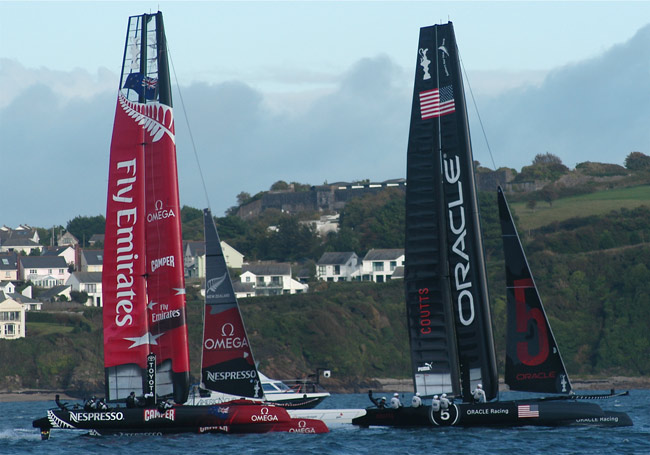 |
|
Photo:©2011 CupInfo |
CupInfo:
Are you looking forward to having the 72s on the America's Cup World
Series? How will this impact the choice of venue, or the distance to
spectators onshore?
Iain Murray:
The 72s wonít be on the World Series. AC45s are continuing through and the 72s will be specific to San Francisco and the Americaís Cup.
CupInfo:
So will you change the course design for San Francisco?
Iain Murray:
No, the course design for San Francisco is what it is, weíve specified the course area, weíll be defining the course more in the future, but itís always been a course for 72s. And the courses we're developing for the 45 circuit are flexible for the venue, but they will all have a similar recipe.
CupInfo:
After 2013, should Americaís Cup 35 continue on the same trend with the
World Series, do you think the 45s will be used for the World Series?
Iain Murray:
I hope so. An awful lot of effort has gone in to the 45s and clearly itís something thatís gathering momentum. I see the AC45 Americas Cup World Series blowing straight past the Americaís Cup and on into the future.
CupInfo:
Thanks Iain!
---©2011 CupInfo.com